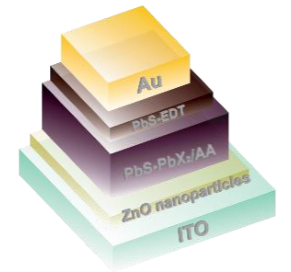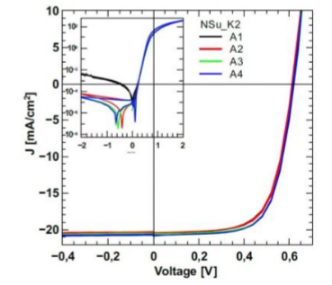PbS QD Solar Cells
QDot™ PbS QDs can be utilised in solar cells to capture more solar spectrum in the near infrared range. The QDs' absorbance wavelength in the NIR range can be tuned, making the QDs promising for tandem solar cells made with other materials, such as silicon or perovskite solar cells. Current development of a stand alone PbS solar cell has already achieved 10% certified efficiencies.
Benefits of using QDot™ PbS QDs for solar cells:
- Broad tunable absorption in near infrared range from 700 to 2000 nm
- Enable solution and room temperature processable solar cell
- Can be tandem with other solar cell technology such as silicon or perovskite solar cell, adding up to 5% to the total power conversion efficiency

Performance:
|
Material
|
QDot™ PbS Quantum Dots
|
|---|---|
|
Absorption range
|
Through all visible up to NIR (tunable from 700 nm to 2000 nm)
|
|
Particle sizes
|
From 2 to 10 nm depending on the required absorption profile
|
|
Devices typical PCE
|
8-9 % upon excitation in NIR
|
Device example:
QDot™ PbS QDs with absorption 920 nm were used as an active layer in the solar cell with gold electrodes and ZnO electron transporting layer. QDot™ PbS QDs treated with PbI2/PbBr2 and ammonium acetate were deposited by spin coating as an active layer. For hole transporting layer, layer processing consisted of ligands exchanged QDot™ PbS QDs with 1,2-EDT was used.
The device absorbs the light through all visible spectra up to NIR light (tunable from 700 - 2000 nm). The obtained solar cell using our PbS QDs show promising power conversion efficiencies up to 8.77%.

|
Measurement
|
Jsc
|
Voc
|
FF
|
PCE
|
Area
|
|---|---|---|---|---|---|
|
A-1
|
20.66
|
0.62
|
0.66
|
8.45
|
0.10
|
|
A-2
|
20.54
|
0.61
|
0.67
|
8.45
|
0.10
|
|
A-3
|
20.68
|
0.62
|
0.68
|
8.69
|
0.10
|
|
A-4
|
20.88
|
0.62
|
0.68
|
8.77
|
0.10
|

